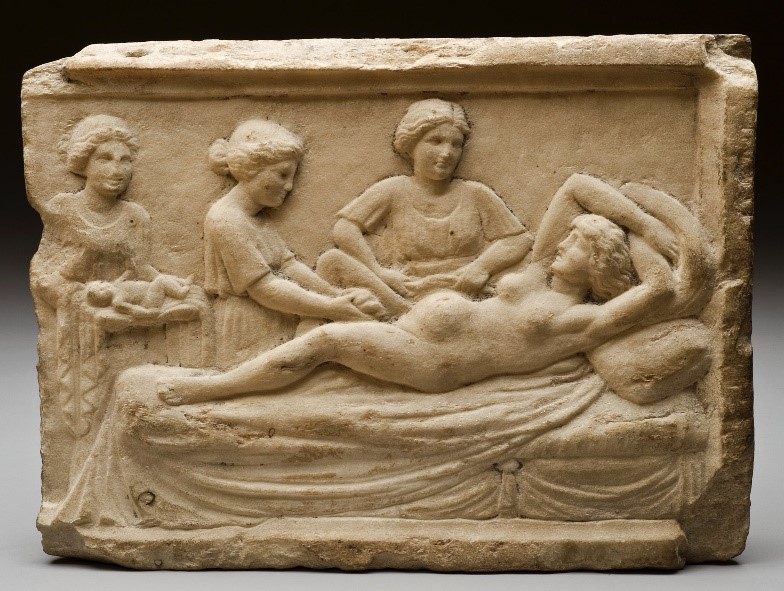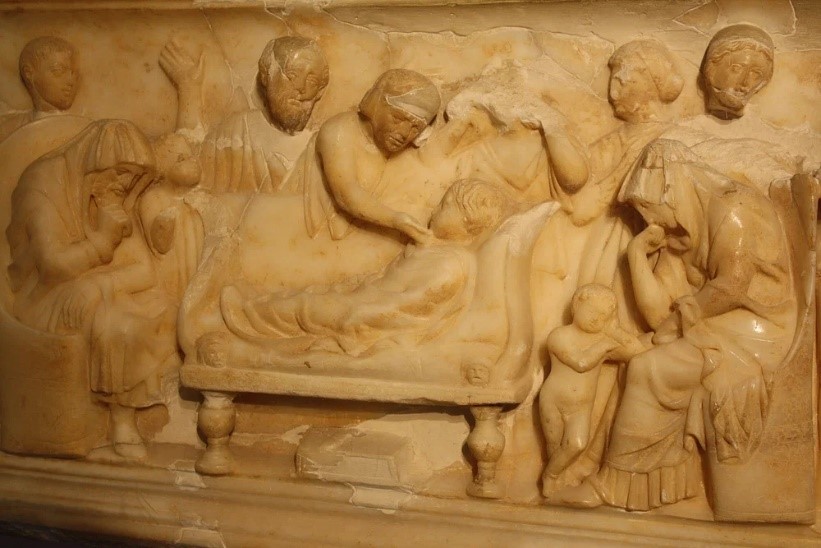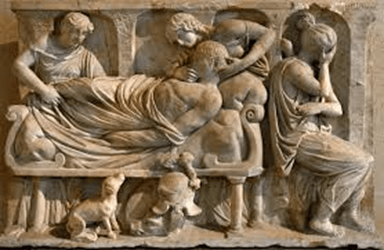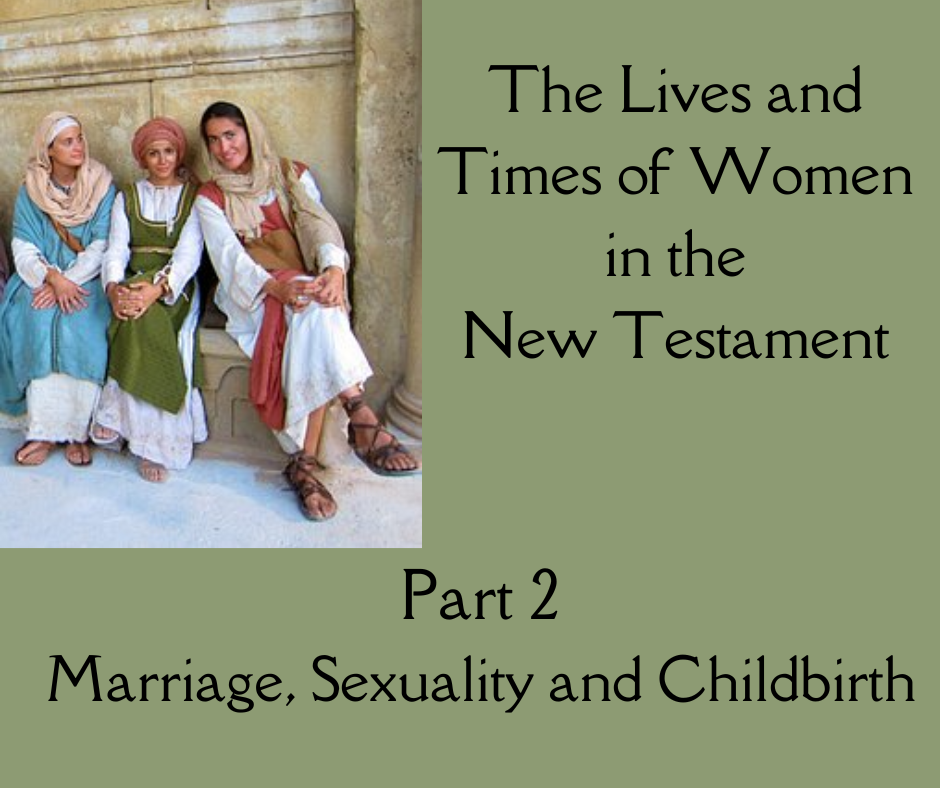Marriage, Sexuality and Childbirth
Welcome to part 2 of my series on the lives and times of women in the New Testament. In part 1, I examined women in a patriarchal society, and this time we will look at women’s everyday lives in terms of marriage, sexuality and children. Life was tough and disease was rife. Life expectancy was short, and for women pregnancy and childbirth were dangerous times, and their life expectancy was shorter than that of men.
Throughout Judea and the wider Roman world, customs were diverse, depending on where you lived, your wealth and status. There was not one view of women, either in Judaism or the pagan Roman way of life, and there were many competing voices.
The Mishnah was the oral Torah and is the written tradition of Rabbinic Judaism, written in about the third century CE. It was concerned with putting everything in its rightful place. Sometimes it saw women with certain rights as a person in her own right. Yet at other times, she was the property of the man. (1)
A woman was expected to be both modest and industrious, and this was true in both Judaism and the Roman world. Conversely, these were also prized as leadership qualities and may even have opened up some women to participate in civic life. (2)
Honour and Shame
Throughout the empire, women were subject to a climate of honour and shame. They were to know their place, to not take authority or to socialise with men outside their family. If she stepped out of these roles, then she could bring shame to her family. The ideal wife should be a support to her husband, submissive and concern herself with the running of the home and family. (3). Considering this, it is even more remarkable that Jesus included women, like Joanna and Mary Magdalene, within his close group of disciples who followed him throughout Galilee and Judea.
Menstruation
According to Mosaic law, a woman with a flow of blood, such as when menstruating or after childbirth, was unclean or impure. Whatever they touched, lay on or sat upon would also become impure, and they could transfer their impurity to the sacred. This led to them being secluded in their home, and anyone wanting to remain pure would have to avoid them. This may not have been practicable in poorer households, and to seclude valued family members may have led to economic difficulties. How much it was observed in Jesus’s day is debatable, other than them not being allowed into the temple in Jerusalem. (4)
Several mikva’ot, or ritual baths for women, have been excavated in Judea. These were places where a woman could bathe once she had finished her period. After bathing, she was once more ritually pure.
Jesus defied expectations when he allowed a woman who had a flow of blood for twelve years to touch his cloak and be healed. He calls her daughter and sends her away in peace.
Marriage
A woman had little control over her body and was expected to marry shortly after puberty, and her first marriage could be in the mid-teens. Her husband would be a man chosen for her by her father, or parents, and this was often an older man. Which would only strengthen the secondary role she had in the marriage. The legal age for marriage in the Roman world was 12 for girls and 14 for boys, but the actual age could have been higher. (5) Marriage was often viewed as the acquisition of the wife for a man who then owned the wife and her sexuality. He paid for her virginity as any other commodity. (6)
The husband had total control over the wife as the paterfamilias, or male guardian, of the family. The wife was expected to stay at home and concern herself with the smooth running and management of the home and any slaves, and to delivering and raising children. This may have been the ideal, and there was a great variety of what a wife way have been able to do, such as women running market stalls and businesses. For example, Lydia in Acts ran her own successful cloth-dying business in Philippi.
Children and childbirth
The main duty of a woman was to be a wife and mother, and the main reason for marriage was procreation and the raising of children. With no modern contraception, women bore many children, but it is estimated that nearly half died by the age of ten. Childbirth was a very dangerous time for women, and from the emperor’s wife to the slave, there was little difference. Their job of producing children was fraught with danger. Perhaps one in fifty childbirths resulted in maternal death, with a higher chance if the mother was young. (7)
Many unwanted children, particularly girls and children with disabilities, were killed or left to die by exposure on rubbish tips. By the end of the New Testament period, Christians often found these children and brought them up as their own. This was one reason for a gender imbalance in the church.
Failing to produce a child was a failure in the one thing women were expected to achieve, and a source of great shame. Philo, a Jewish philosopher who lived at the same time as Jesus, suggested that a man should divorce a barren woman, and took pity on the man who stayed with her out of familiarity. He had no sympathy for the man who married a woman who had previously failed to produce children. (8)
Widowhood
The gospels give us a picture of widows as poor and vulnerable, such as the woman who put a few small coins in the temple collection when she could ill afford to give them. If she had no sons to look after her and no longer had a male guardian, then she was very vulnerable indeed.
A young widow was expected to remarry, but after the age of thirty, when her child-rearing days were over, there could be no expectation of marriage. A woman could be widowed and remarried several times, such as the Samaritan woman who met Jesus by the well.
After death, the property of the husband was distributed according to his will, with preference to his children. Usually, the inheritance was passed to his sons, and if no sons, then to his daughters. In Roman marriages, the wife’s dowry and property were viewed as part of her family of origin and, supposedly, kept separate from her husband’s property. Upon death or divorce, this should be returned to the wife, if there was any left, that is. If the widow was fortunate and received a sizable inheritance, she may have been able to live a life of relative freedom.
Divorce
It was shameful to be divorced and there was a stigma about it, and this continues today. Children would usually stay with the father, and this would often make divorce less desirable for a mother to leave her children.
Divorce could be granted for several reasons, such as failure to conceive. Certain women may have been able to initiate a divorce, but only a man could enact one. Meaning that a woman could be divorced against her will, but a man never against his. (9)
In Jesus’ time, there were opposing ideas about divorce. Some rabbis believed that a husband could initiate a divorce if he found any indecency in his wife. This could be for any reason, even if the wife spoiled his dinner or he found someone fairer than her. Other rabbis said that divorce should only be granted in cases of the woman’s adultery. Both views focus on the rights of the man and the rights of the woman were of no consequence. In light of this, Jesus’s comments on divorce in Matthew 19 can be seen as giving rights and protection to women.
Many elite women in the Roman world owned property, and could keep this and their dowry upon divorce. Marriage did not require a document or a legal process, simply an agreement to live together. Likewise, when they no longer wanted to be married, they could decide to divorce. The legal documents only agreed to the dowry. (10)
Prostitution and Adultery
The leaders of the day denounced Jesus for eating with prostitutes and tax collectors. This may not have meant sex workers as we would view them today, but a slur against women who transgressed accepted laws, rather like the word “slag” in colloquial English. This highlights the bravery of the respectable women who followed Jesus and risked their good name.
Both Romans and Jews were encouraged to divorce a woman guilty of adultery. Augustus’s marriage laws said that a man who did not divorce his wife for adultery could be viewed as condoning it and even be charged as a pimp. (11) This highlights the double standard for women’s behaviour, as there was no such law for a husband’s adultery. Jesus met a woman who was caught in adultery and dragged to him. He disarms her accusers and when they have all gone, he responds to her with kindness.
Conclusion
It is impossible to give a generalised view of women’s lives in the first century because it varied due to where she lived and the family circumstances of her home. Many women were attracted to the freedom that believing in Jesus gave her and joined the church as it spread across the Roman Empire.
Next month, be sure to look out for my next blog in the third part in the series when I will look at the everyday and spiritual lives of women in the New Testament.

Terentius Neo and his wife, Fresco Pompeii

Roman relief from a funerary monument Fitzwilliam Museum

Front of a sarcophagus showing Roman marriage





The Sarcophagus of M. Cornelius Strtius showing scenes from his childhood

Susan Sutherland is the author of three books. To buy Leaving Bethany and the sequel Return to Caesarea please go to the buy page.
If you like Susan’s blogs sign up for the mailing list and receive a free copy of The Aemilia Metella Interviews.
References
(1) Sauder, L (2011) “Sexual Property and the Personhood of Women in the Old Testament, New Testament and the Mishnah,” Consensus: Vol. 33 : Iss. 2 , Article 4. Available at: http://scholars.wlu.ca/consensus/vol33/iss2/4
(2) Hylen, S E (2019) “Women, Children, Slaves, and the Law in the New Testament Period” The Oxford Handbook of Biblical Law. Available at: https://academic.oup.com/edited-volume/34224/chapter-abstract/290211623?redirectedFrom=fulltext
(3) Taylor, J and Bond, H (2022) Women Remembered Jesus’ Female Disciples, Hodder and Stoughton, p11-12
(4) Taylor, J and Bond, H (2022), p 88
(5) Hylen, S E (2019) “Women, Children, Slaves, and the Law in the New Testament Period”
(6) Sauder, L (2011) “Sexual Property and the Personhood of Women in the Old Testament, New Testament and the Mishnah,”
(7) Beard, M, SPQR A History of Ancient Rome, (2016), Profile Books, p314
(8) Taylor, J and Bond H, p 85
(9) Mowczko, M, Jesus on Divorce, Remarriage and Adultery, Available at: https://margmowczko.com/jesus-divorce/
(10) Hylen, S E (2019) “Women, Children, Slaves, and the Law in the New Testament Period”
(11) Hylen, S E (2019) “Women, Children, Slaves, and the Law in the New Testament Period”

One thought on “The Lives and Times of Women in the New Testament- Part 2”